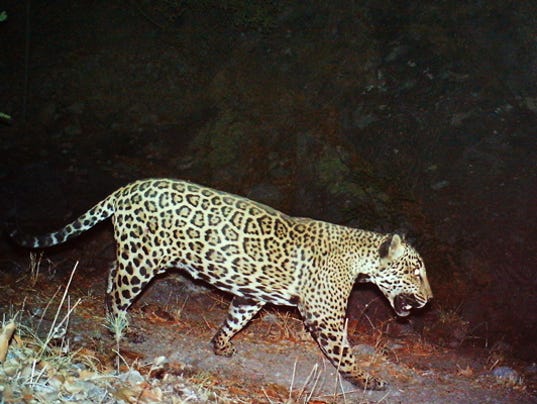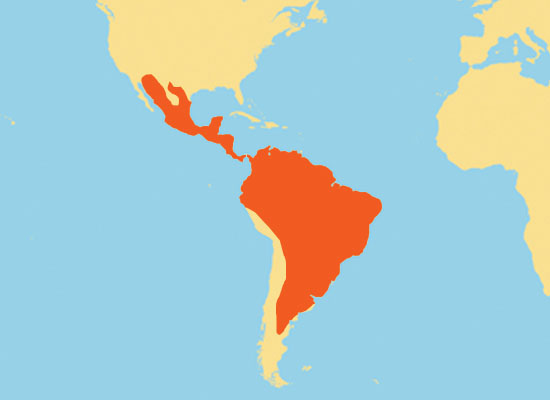When
one thinks of a Jaguar, they typically think of a fairly large cat skulking
through a thick rain forest. Now, if I were to ask what countries the jaguars
actually resides in; I would probably get a variety of different countries,
mostly in South America. But what if I told you that the jaguar once roamed the
southern United States. There was actually a recent sighting in Arizona of a
jaguar roaming the local mountain range. This is not the first sighting of this
elusive cat in recent years. Since 1996, as many as seven jaguars have been
documented in southern Arizona and southwestern New Mexico (1).
The last cat that was previously found in the United States was given the
nickname of “El Jefe” which translates to “The Boss” in Spanish. El Jefe was
first spotted in 2013, and researchers believed he was the only wild jaguar in
the United States until this new jaguar was spotted in early December of 2016.
El Jefe and this new jaguar are both males, so even if this cat crossed paths
with El Jefe, no mewing jaguar kittens would result to increase the population
(2).
 |
|
A picture of “El Jefe”
taken by a trail camera.
Photo: The
Arizona Republic
|
Even if there is little hope for the population of these
cats to make their way back to the United States, this is still great news to
hear. Two jaguars living in the United States where most residents did not even
know that Jaguars even existed. The
ever-expanding United States was actually the cause of the jaguar’s demise in
the first place. As cities and companies needed to expand, the deforestation of
certain areas was the response to adjust to the growth. During the last 100
years the big cats almost completely vanished from the continental U.S. thanks
to habitat loss and federal programs aimed at protecting livestock (3).
The jaguars would harm livestock, and farmers saw this as a loss of profit and
would take care of the situation as they saw fit. They would hunt and kill the
jaguars, so, that could not harm their livestock ever again. Also, the fur of
the jaguar was highly coveted. All of these were factors that led to demise of
the jaguar population in the United States.
 |
|
A
map of the jaguar’s range.
Photo: Defenders of Wildlife
|
But worry not, because there are groups who are dedicated
to help conserve the jaguar population in northern Mexico and southern United
States. The Northern Jaguar Reserve in Sonora, Mexico, main focus is to protect
the northernmost remaining jaguar population. Initiated in 2003, the growing
reserve protects key habitat for the last breeding population of northern
jaguars—offering hope for their recovery in the United States (4).
Jaguars in northern Mexico need to be protected so that the jaguar population
can re-enter Arizona and be re-established in the U.S (5).
As long as conservation efforts maintain a success rate then the future hope
would be to slowly introduce those jaguars back into the United States. This is
just one group that is trying to make a positive effort to help the jaguars.
Another way that groups have been trying to help conserve the jaguar population
is urging the U.S. Fish and Wildlife service to set up an effective plan that
is actually beneficial towards the population. In recent years, the U.S. Fish
and Wildlife undervalues the importance of the jaguar’s northern range and
fails to prescribe adequate conservation measures to help the jaguar recover
its former U.S. territory (4).
From a governmental stand point, it seems as if they do not want the jaguar to
be reintroduced into the United States. If the population would become educated
on the cat and the history it has with this nation then hopefully we could
correct our wrong.
As long as groups like Defenders of Wildlife stay
persistent in their goal to hold government to stay true to listening to the
public to conserve the jaguars, then I could see a positive effort being made.
Right not now the government is minimalizing their effort, but if they actually
draft a plan that is worthwhile that actually encompasses all of the jaguars’
needs then I could see big things start to happen. The U.S. Fish and Wildlife
Service must issue a robust recovery plan that supports the restoration of
jaguars to the full array of ecological settings that they occupied before they
were eradicated (4).
So, is the jaguar making a comeback to the United States? As of right now, I
say it is a longshot for the jaguar to make a return to the United States given
the circumstances of the governing body. As long as conservation groups are
still arguing in favor of the jaguar then there still is hope.
No comments:
Post a Comment